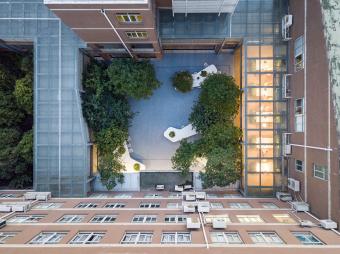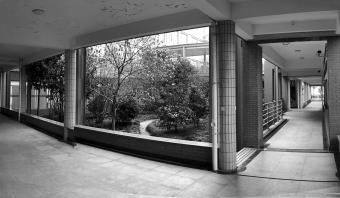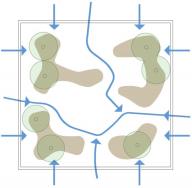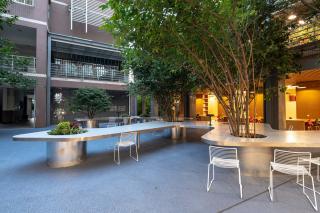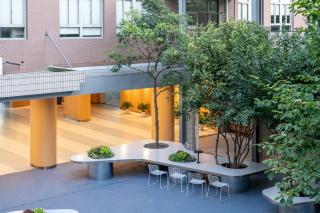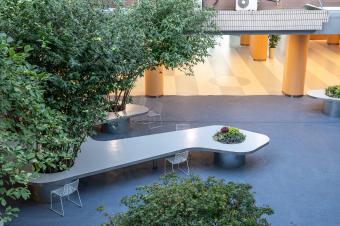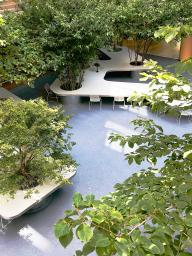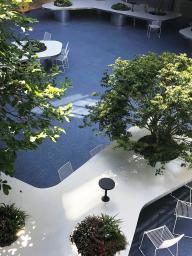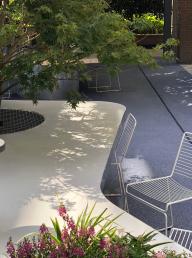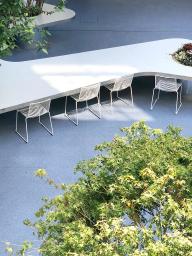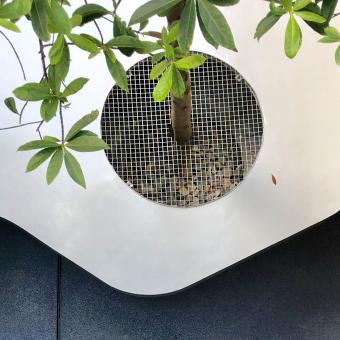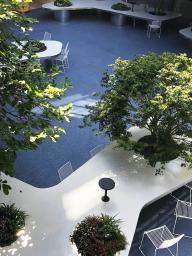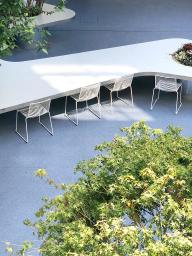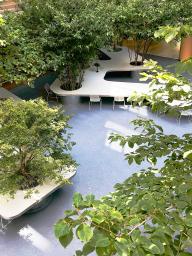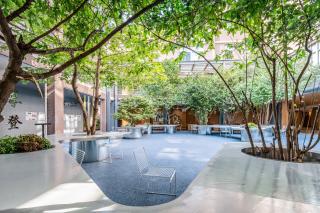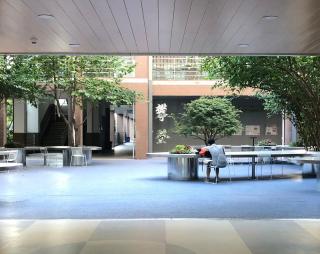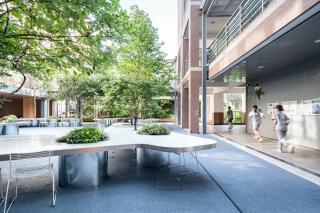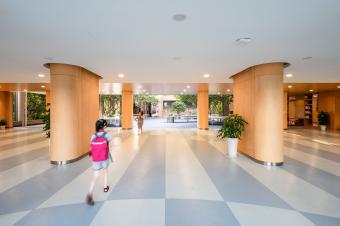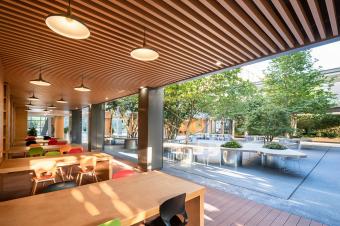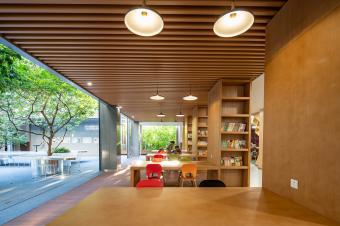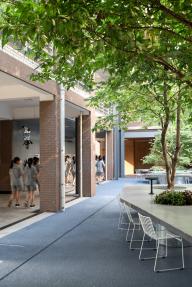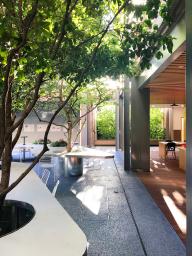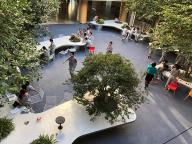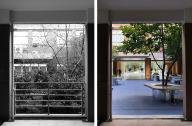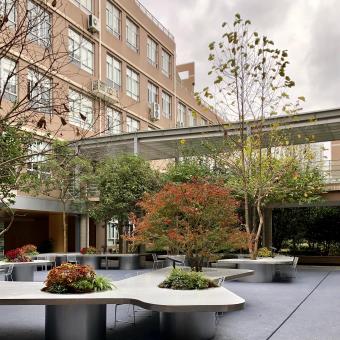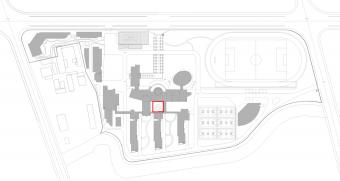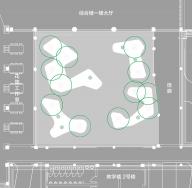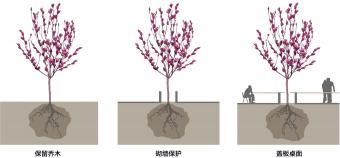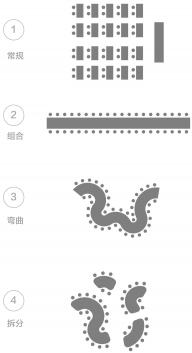概述
Statement
在中國(guó)���,超過(guò)90%以上的中學(xué)都是公辦學(xué)校,為周邊社區(qū)提供了良好的基礎(chǔ)教育服務(wù)���,但傳統(tǒng)的校園偏重于教室與實(shí)驗(yàn)室這些教學(xué)功能�����,對(duì)公共空間缺乏足夠的關(guān)注�����。在室外�����,綠地雖然很多�,但真正活動(dòng)和交流空間卻很少,并且缺少活力��。
In China, more than 90% of secondary schools are public schools, which provide good basic education services for the surrounding communities. However, the traditional campuses focus on the teaching functions of classrooms and laboratories, and lack sufficient attention to public spaces. Outdoors, although there are many green spaces, there are few real activities and communication spaces, and they lack vitality.
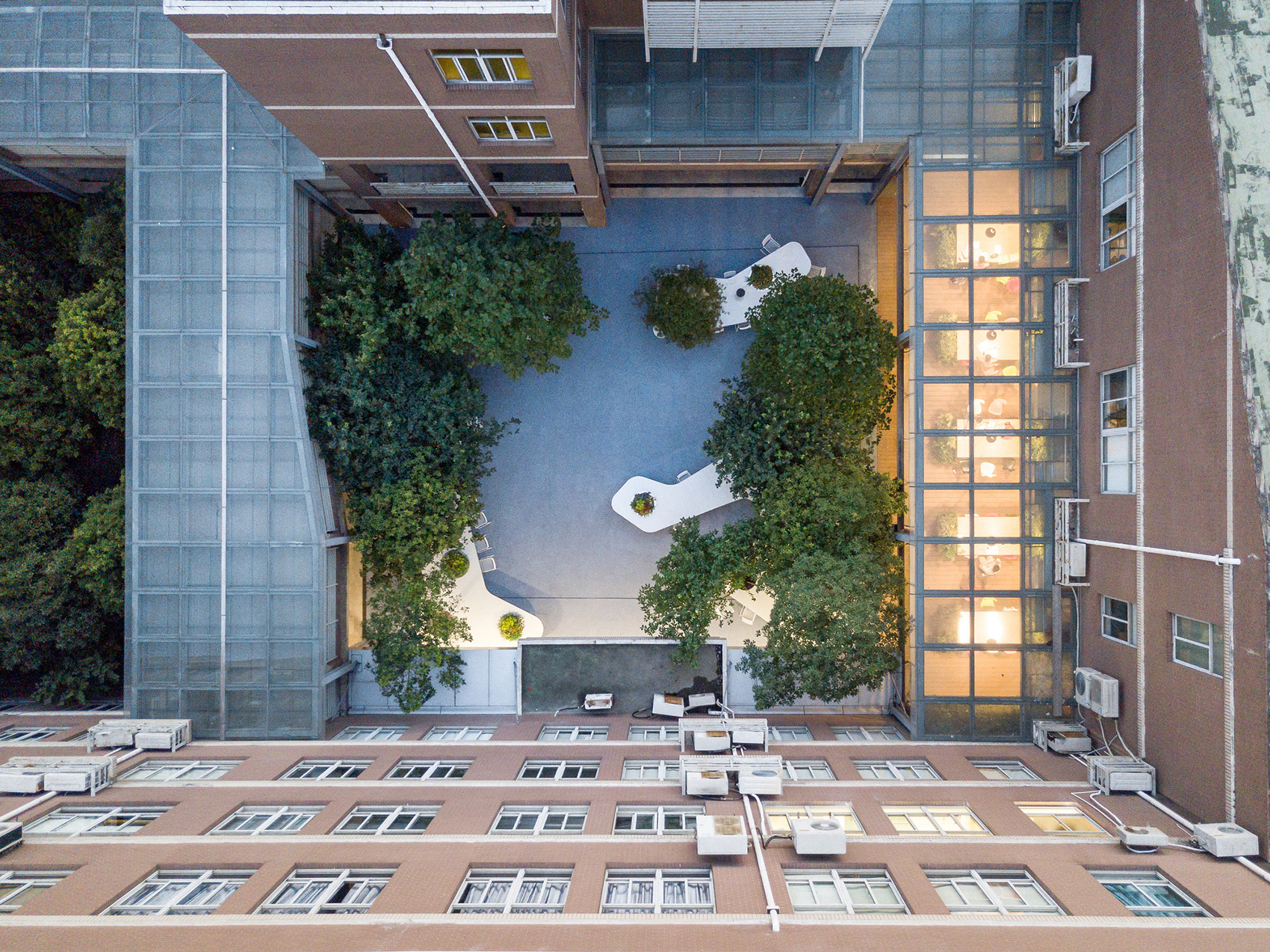
▲庭院鳥(niǎo)瞰
為適應(yīng)當(dāng)代學(xué)生教學(xué)和生活的新需求��,上海市實(shí)驗(yàn)學(xué)校(Shanghai Experimental School���,SES)在近兩年進(jìn)行了一系列的校園空間改造與更新��。改造重點(diǎn)之一的就是位于校園建筑群核心的樹(shù)桌花園����。
改造設(shè)計(jì)在有限的尺度里將一個(gè)乏味的封閉綠化庭院變成了一個(gè)充滿(mǎn)活力和趣味性的積極空間����,為學(xué)生們提供了室外上課�����、做實(shí)驗(yàn)��、聚餐以及做游戲的新空間�,鼓勵(lì)學(xué)生之間的交往與團(tuán)隊(duì)協(xié)作��,為校園生活帶來(lái)有了更多的可能性���。
In order to adapt to the new needs of contemporary students' teaching and living, Shanghai Experimental School (SES) has carried out a series of indoor and outdoor renovations and updates in the past two years. One of the key points of the renovation is the tree-table garden at the heart of the campus complex.
Renovation design transforms a boring closed green courtyard into a dynamic and interesting positive space on a limited scale, providing students with a new space for outdoor classes, experiments, dinners and games, encouraging students to The interaction and teamwork bring more possibilities to campus life.
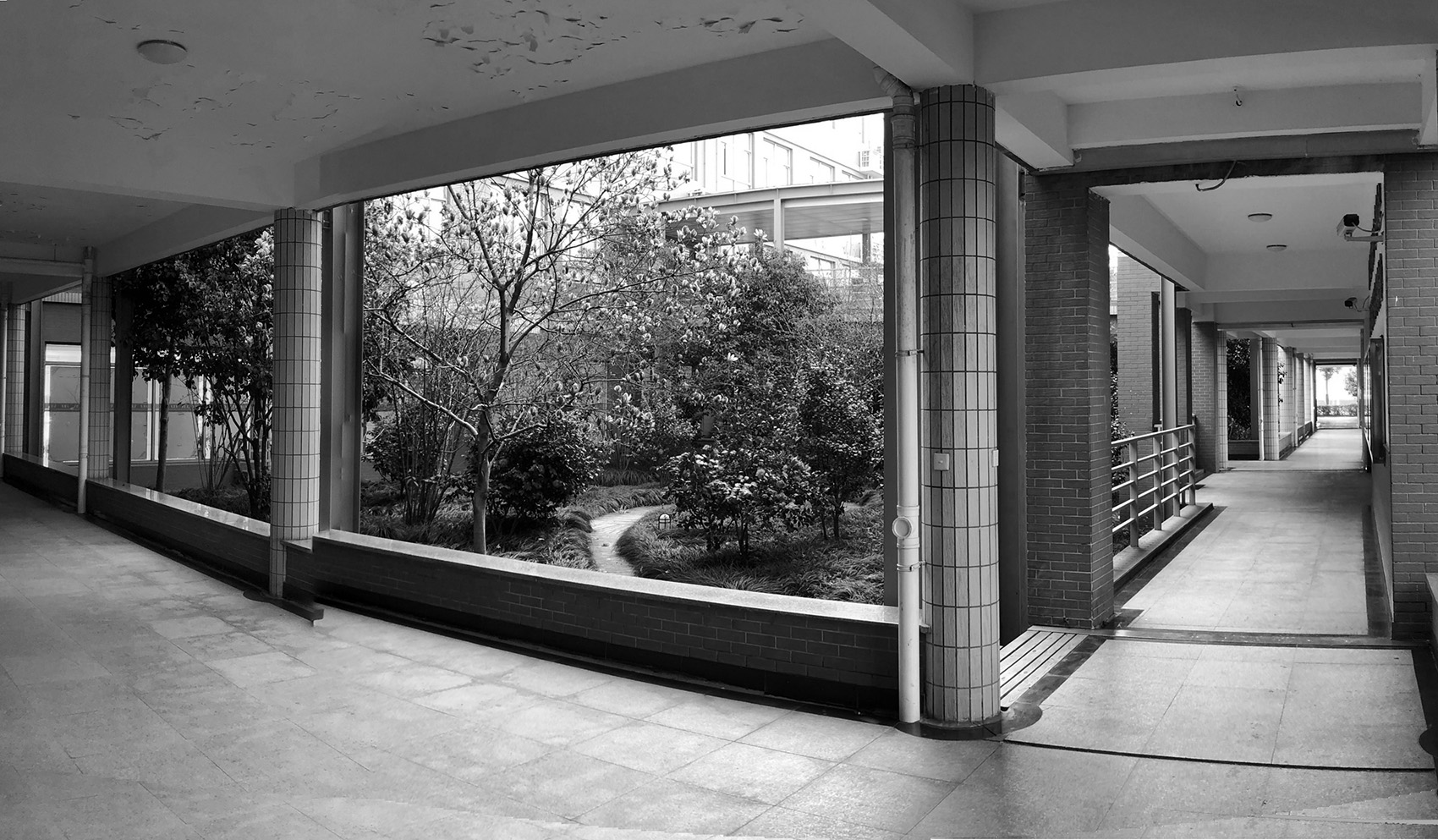
▲庭院原貌
設(shè)計(jì)說(shuō)明
Narrative
項(xiàng)目背景
Background
面對(duì)當(dāng)代學(xué)生的教學(xué)和生活的新需求,上海市實(shí)驗(yàn)學(xué)校學(xué)校(SES)開(kāi)展了對(duì)校園室內(nèi)外多個(gè)空間的系列化改造����,希望新空間能夠幫助學(xué)校開(kāi)展多樣化的教學(xué)工作,同時(shí)能夠給學(xué)生提供更多多樣化的活動(dòng)空間�。
樹(shù)桌花園改造前是位于幾棟教學(xué)樓之間的一片正方形庭院,雖然地處學(xué)校中心位置���,卻十分封閉��。其中10年前種下的植物經(jīng)過(guò)多年生長(zhǎng)后雖然茂盛��,但卻顯得有些雜亂��,幾乎從各個(gè)角度都遮擋了視線����。庭院邊的走廊連接著食堂和體育館,使用率很高��,卻被欄桿阻隔��,令人幾乎無(wú)法進(jìn)入庭院�����。與庭院緊鄰的一樓大廳是學(xué)校建筑的重要要出入口�,由于庭院面貌不佳,朝向庭院的落地玻璃被全部貼上了海報(bào)���,嚴(yán)實(shí)密閉����,使得整個(gè)庭院與周邊的關(guān)系更加剝離?�,F(xiàn)狀庭院中的路徑也有些令人迷惑����,既起不到交通聯(lián)系的作用����,也支持不了更多的活動(dòng)���。
SES提出了針對(duì)庭院及周邊建筑空間一體化的改造要求��,景觀設(shè)計(jì)師與室內(nèi)設(shè)計(jì)師共同合作�,希望打造一個(gè)開(kāi)放的�、室內(nèi)外相融合的庭院空間。
Facing the new needs of contemporary students' campus life, Shanghai Experimental School (SES) has carried out a series of transformations on indoor and outdoor spaces in the campus. It is hoped that the new space will help schools carry out diversified teaching work and at the same time Students offer more diverse event spaces.
Before the renovation of the tree table garden, there was a square courtyard between several teaching buildings. Although it was located in the center of the school, it was very closed. The plants planted 10 years ago, although they have flourished after many years of growth, are somewhat messy and obscure sights from almost every angle. The courtyard side corridor connects the canteen and the gymnasium, and the usage rate is high, but it is blocked by the railing, making it almost impossible to enter the courtyard. The first floor lobby adjacent to the courtyard is an important entrance for the school building. Due to the poor appearance of the courtyard, the floor-to-ceiling glass facing the courtyard is all affixed with posters, which are tightly sealed, which makes the relationship between the whole courtyard and the surrounding area more divestiture. The path in the current courtyard is also somewhat confusing, and it does not function as a transportation link, nor can it support more activities.
SES proposed the transformation requirements for the integration of courtyard and surrounding building space. Landscape architects and interior designers work together to create an open, indoor and outdoor courtyard space.
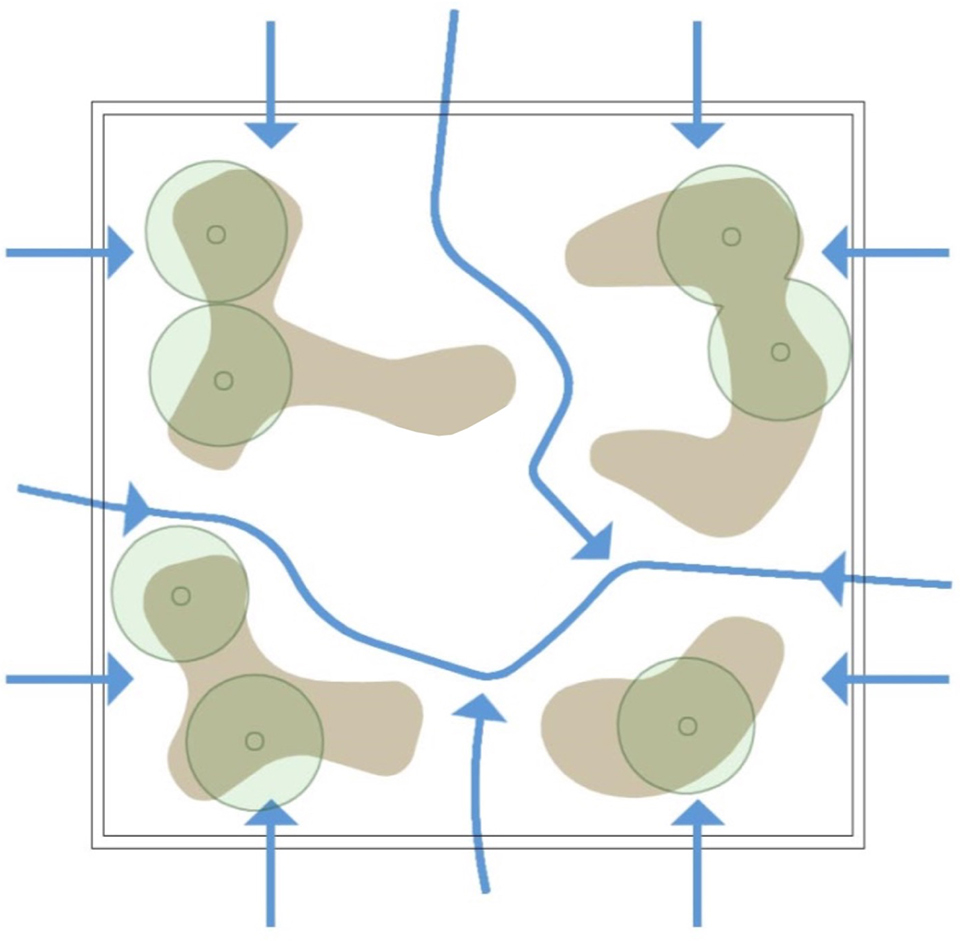
▲動(dòng)線分析
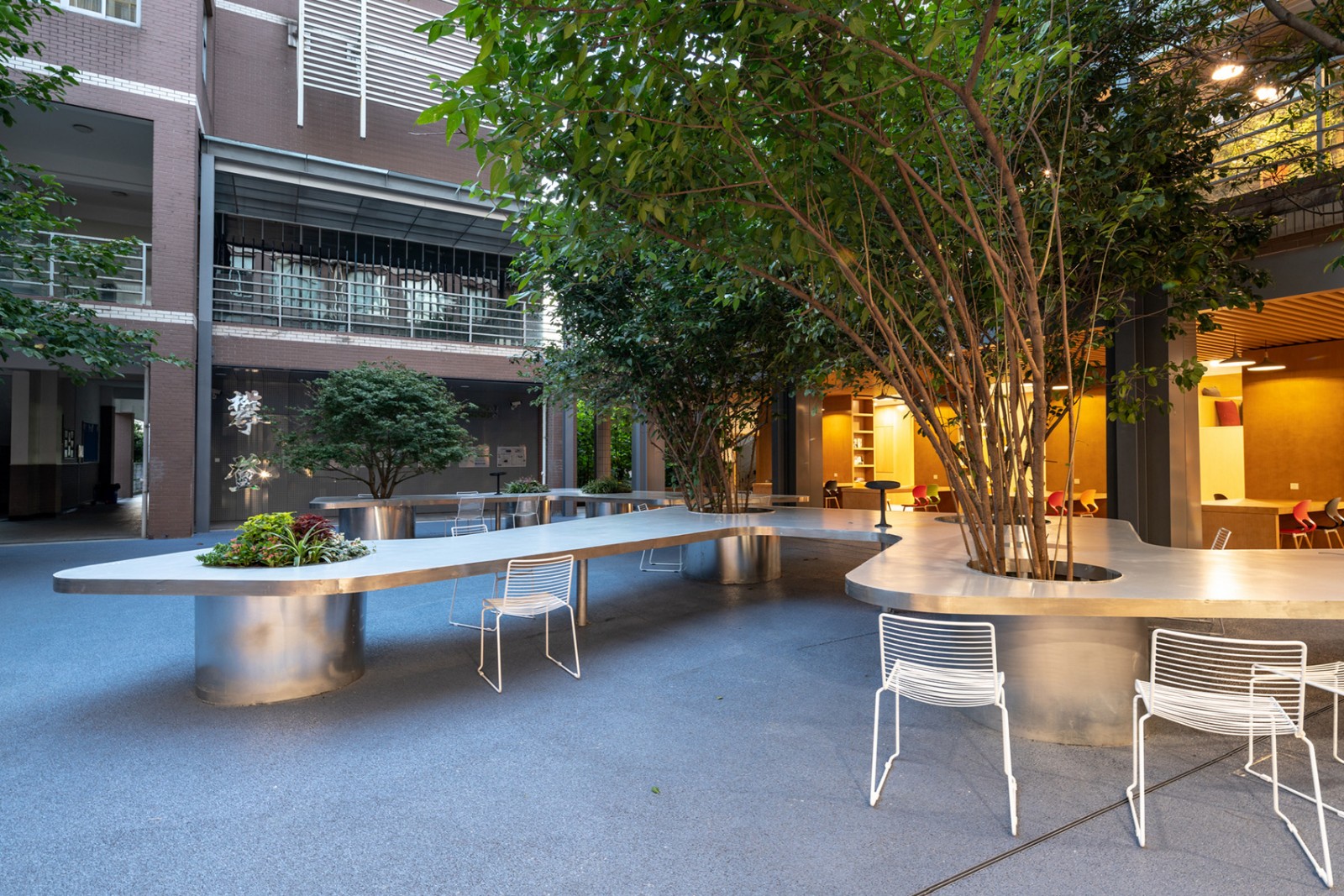
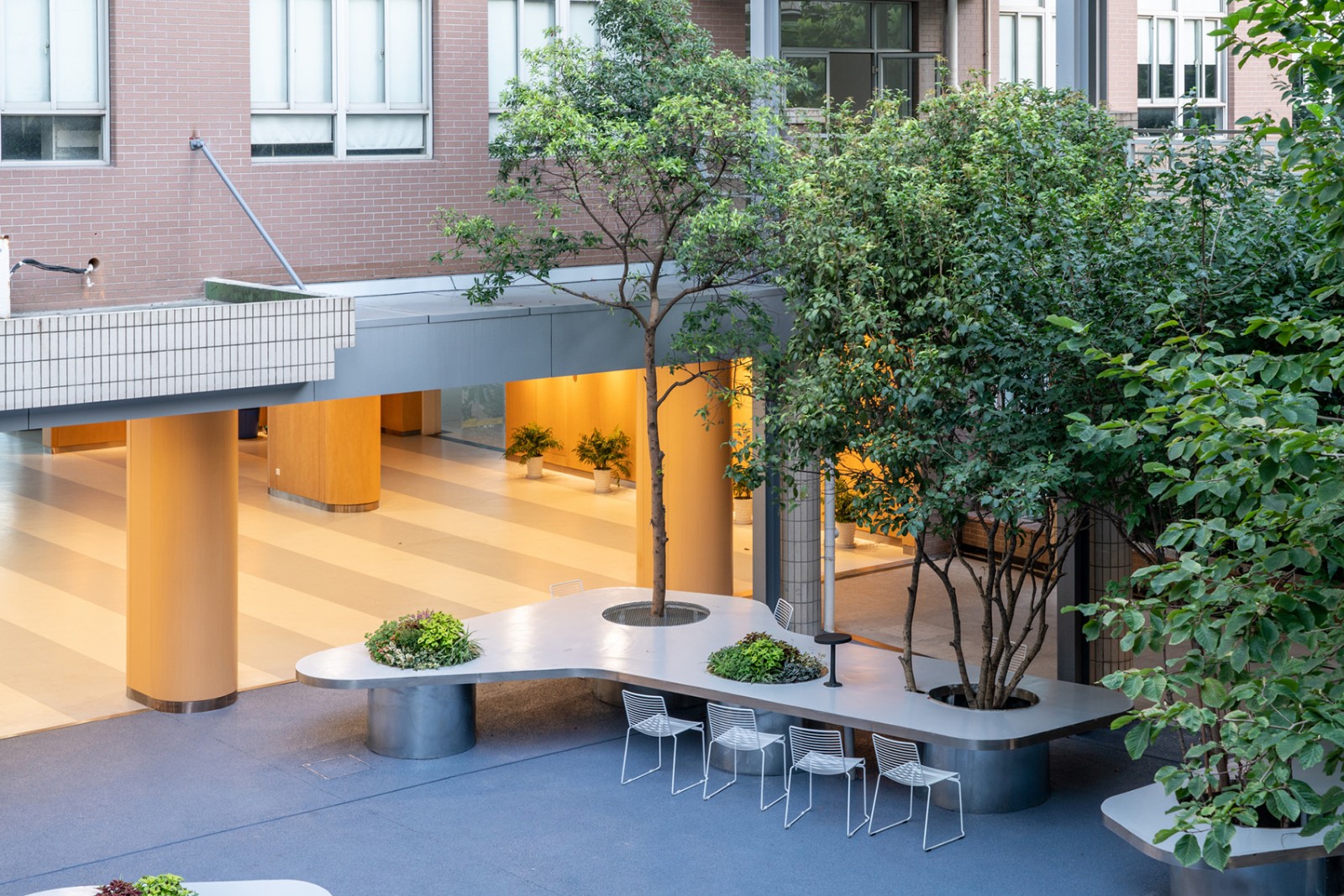
▲樹(shù)桌花園概覽
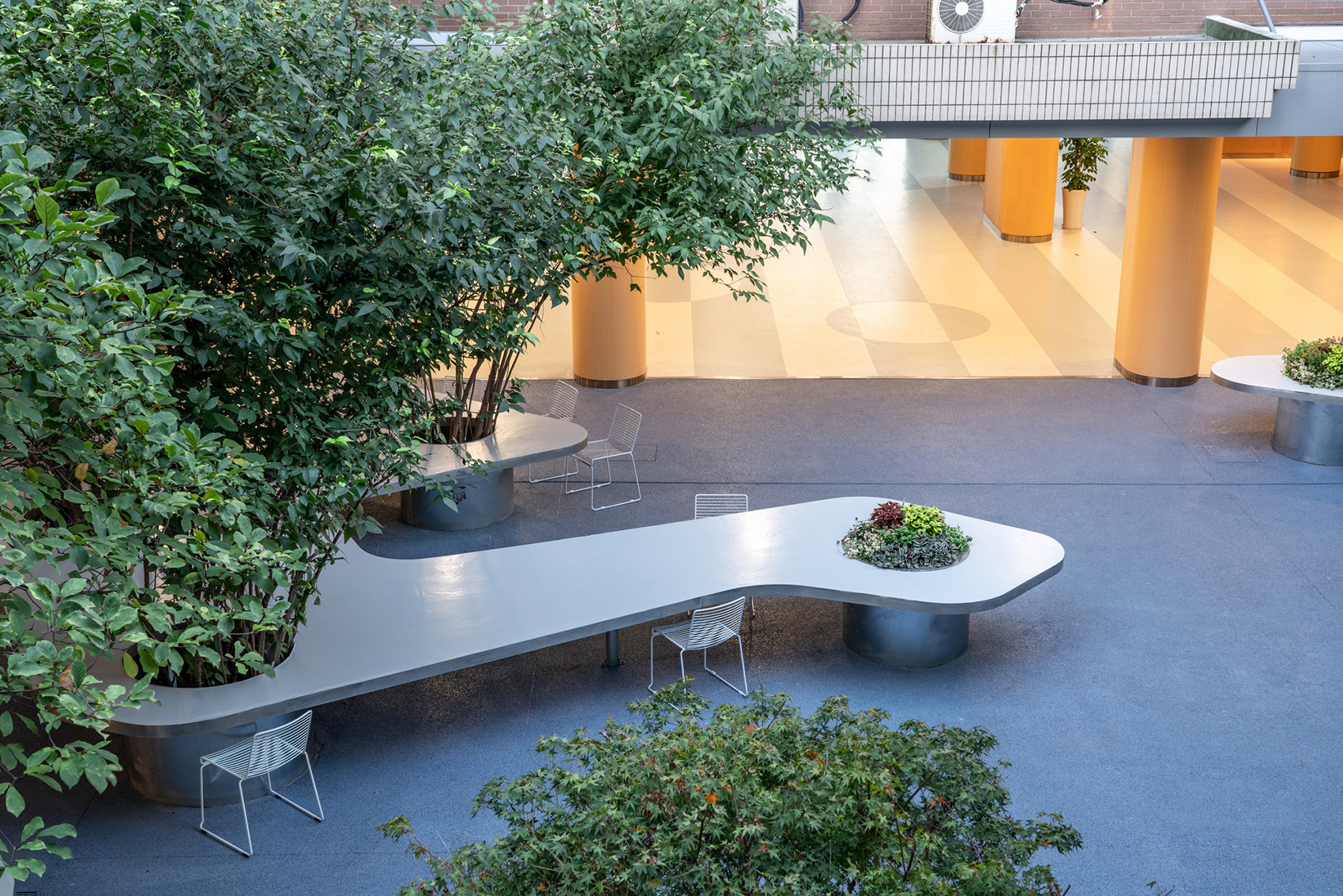
▲樹(shù)桌與大廳
設(shè)計(jì)意圖
Plan for design
改造設(shè)計(jì)力圖最大程度消除花園與建筑空間的隔離�����,建立室內(nèi)室外一體化的空間體系��。庭院空間要更加開(kāi)放����,滿(mǎn)足日常穿行和活動(dòng)的需求�,師生們可以從各個(gè)方向地進(jìn)入,并滿(mǎn)足無(wú)障礙的需求��。庭院空間還能夠滿(mǎn)足學(xué)生們各種多樣化的使用���,如戶(hù)外上課���、班級(jí)聚會(huì)����、自然實(shí)驗(yàn)���、游戲娛樂(lè)等��,也便于舉辦學(xué)校層級(jí)的一些非正式�、輕松的小規(guī)模交流活動(dòng)���。庭院原生樹(shù)木全部保留���,并能成為整個(gè)庭院的重要特征。
The transformation design strives to minimize the isolation between the garden and the building space, and establish a spatial system for indoor and outdoor integration. The courtyard space should be more open to meet the needs of daily walking and activities. Teachers and students can enter from all directions and meet the needs of barrier-free. The courtyard space can also meet the diverse use of students, such as outdoor classes, class gatherings, nature experiments, game entertainment, etc. It is also convenient to hold some informal and easy small-scale exchange activities at the school level. The native trees in the courtyard are all preserved and can be an important feature of the entire courtyard.

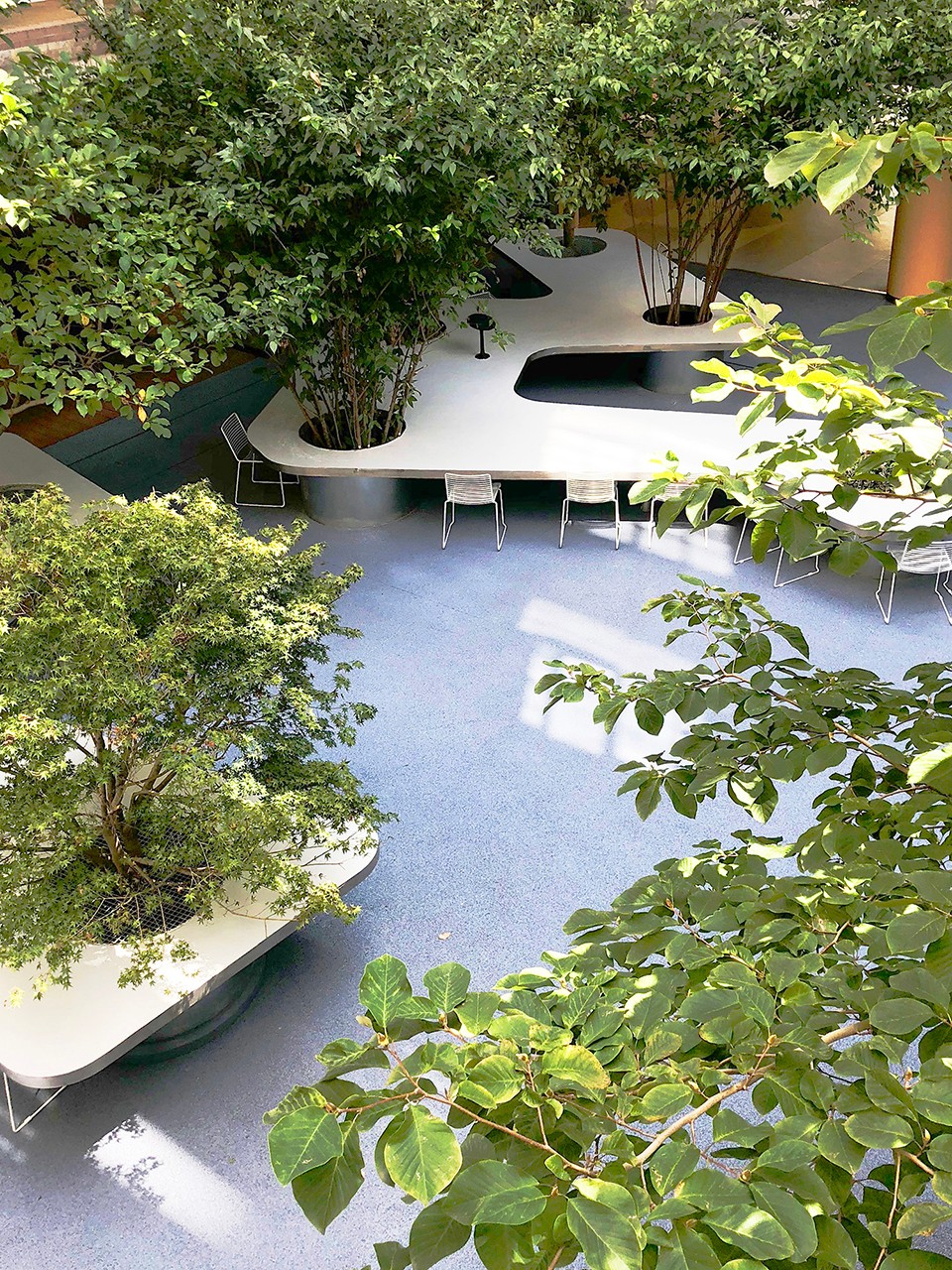
▲保留下的11棵樹(shù)木形成綠意盎然的上層覆蓋
設(shè)計(jì)策略
Strategies
開(kāi)放與連接
Open and connected
與建筑室內(nèi)設(shè)計(jì)師共同合作�����,一樓大廳對(duì)庭院完全開(kāi)放����,連廊空間也拓展為學(xué)習(xí)和交流空間�,與庭院空間完全融合����。
改造后的庭院,采用了全通透的設(shè)計(jì)�����,四周均可進(jìn)入��,內(nèi)部也能停留����,方便了學(xué)生日常便捷無(wú)障礙穿行的需求。綜合樓一樓大廳與對(duì)面的教學(xué)樓的視線聯(lián)系被建立起來(lái)���,校園空間的連續(xù)性得到顯著提升��。
同時(shí)得益于空間的開(kāi)放和視線的通透,樹(shù)木真正成為了庭院中顯著的特色���。?
Working with architectural interior designers, the first floor lobby is completely open to the courtyard, and the corridor space is also expanded into a learning and communication space, fully integrated with the courtyard space.
The reconstructed courtyard adopts a fully transparent design, which can be accessed all around and can be stopped inside, which is convenient for students' daily convenient and unobstructed travel. The line of sight of the first floor lobby of the complex building and the opposite school building was established, and the continuity of the campus space was significantly improved.
At the same time, thanks to the openness of the space and the transparency of the line of sight, the trees have truly become a distinctive feature in the courtyard.
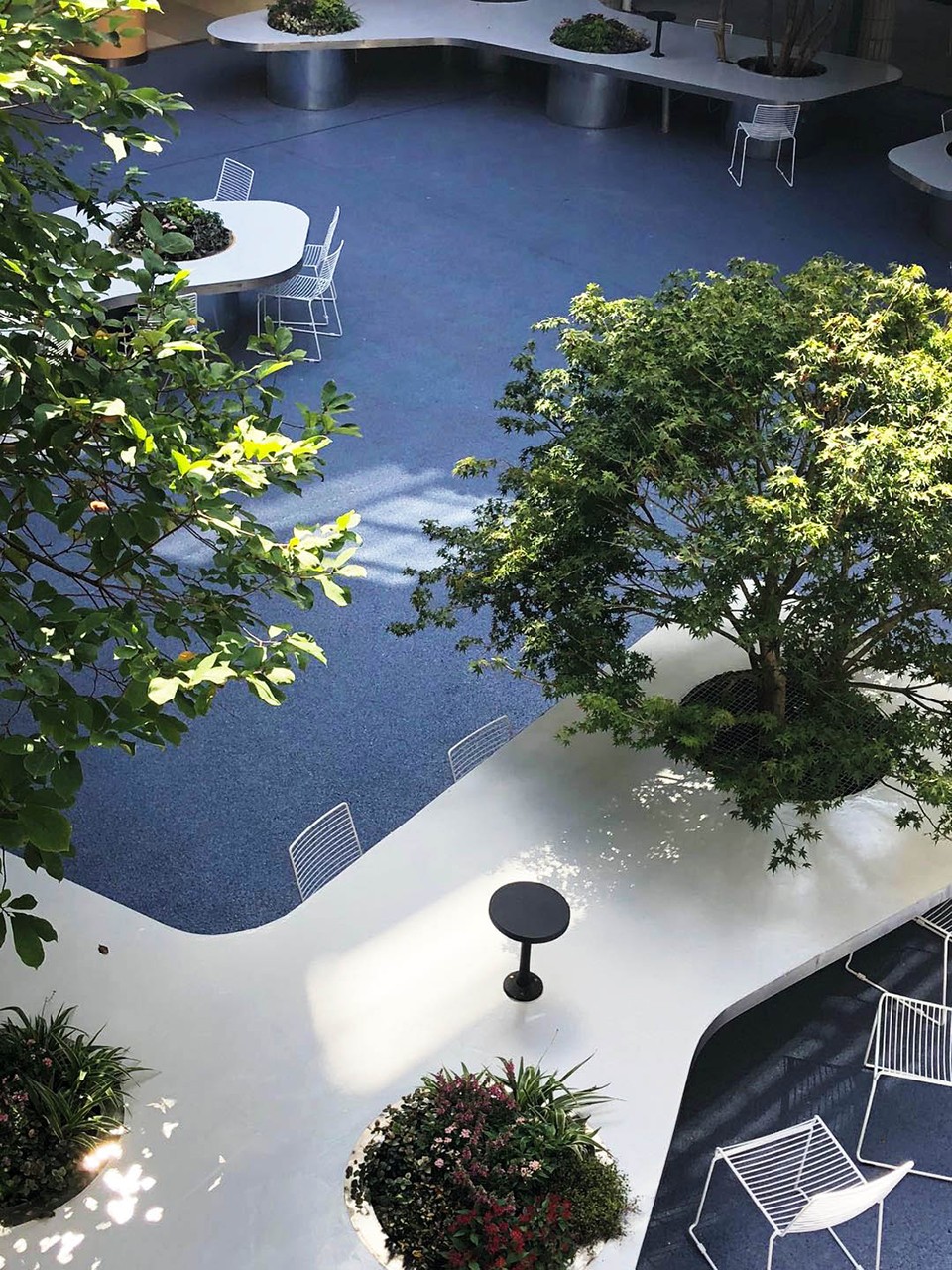
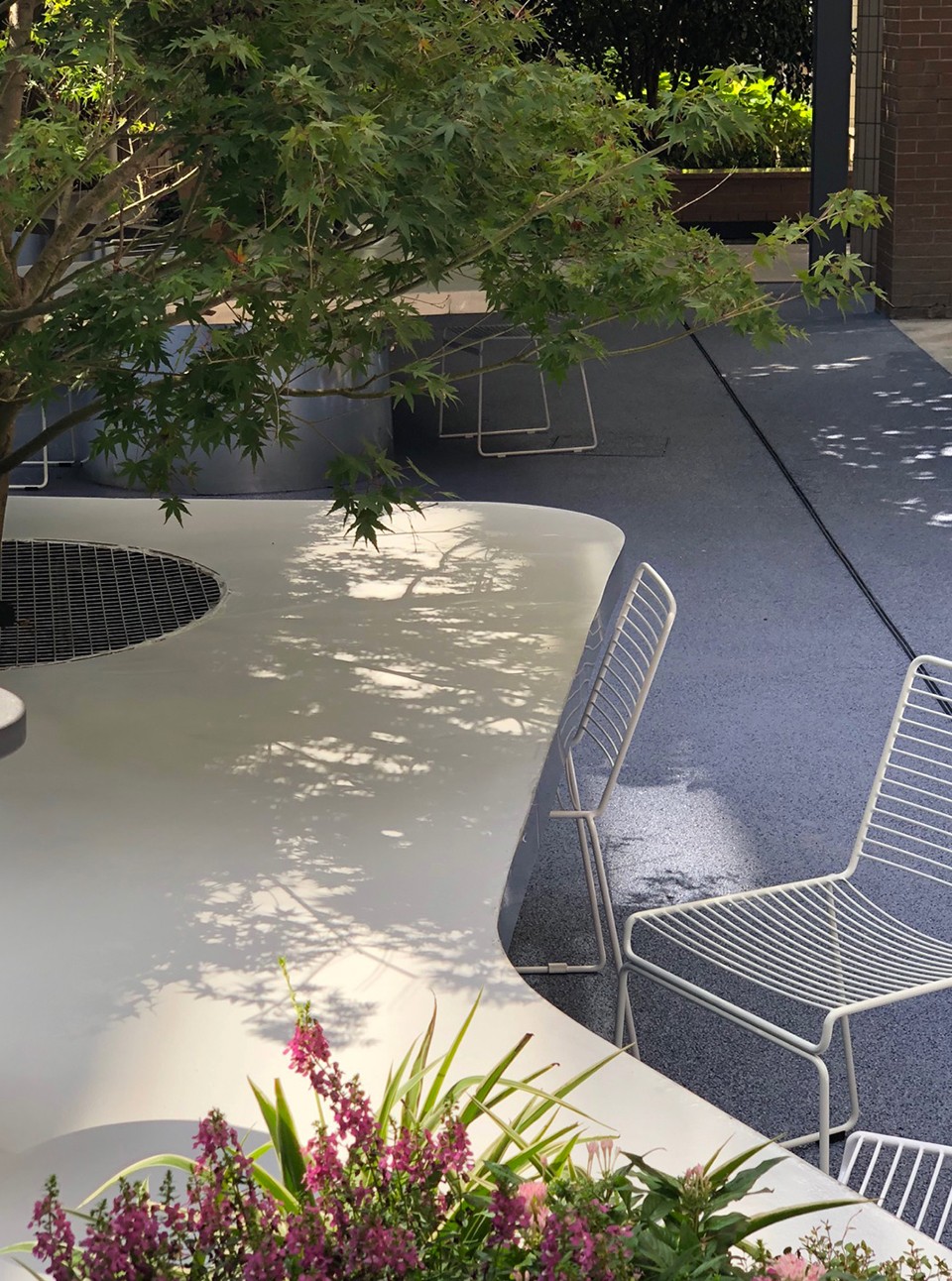
▲樹(shù)桌細(xì)部
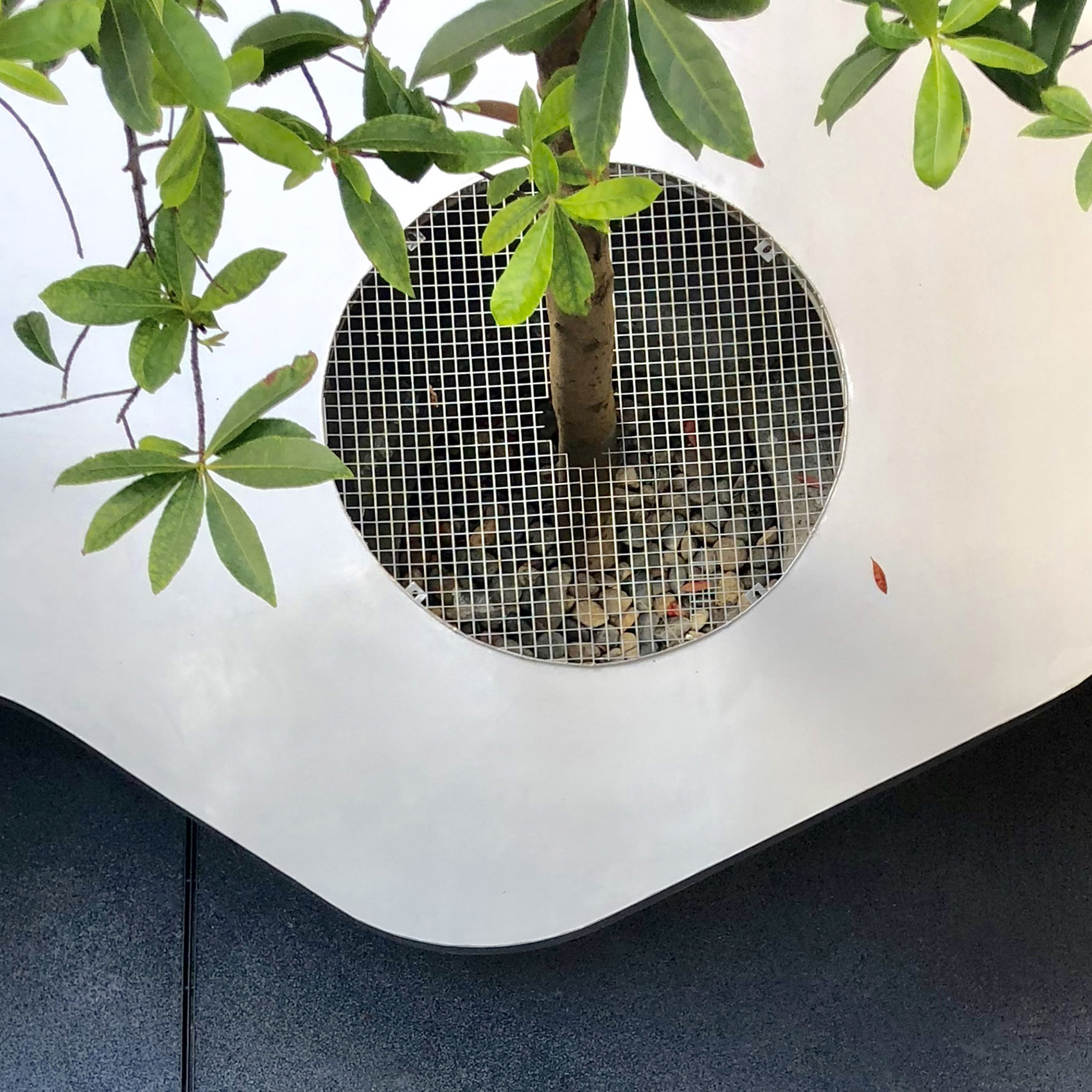
▲樹(shù)桌依照樹(shù)干點(diǎn)位環(huán)繞放置
一個(gè)班的室外課堂與活力空間
An outdoor classroom with a dynamic space
新的庭院最終以樹(shù)木和桌子為主要元素�,被SES師生稱(chēng)為樹(shù)桌花園�����。
作為整個(gè)花園最重要元素的樹(shù)桌,看似自由隨機(jī)的外型����,實(shí)際上也是按照一個(gè)40人班級(jí)的課桌尺度演變而來(lái)。樹(shù)桌定位依照原生樹(shù)干點(diǎn)位環(huán)繞放置�,四組自由曲線型的桌面,流動(dòng)漂浮在大樹(shù)之間�,形成綠蔭下的“樹(shù)桌”,創(chuàng)造出與樹(shù)為鄰的學(xué)習(xí)空間�����,樹(shù)桌的長(zhǎng)度大于一個(gè)常規(guī)班級(jí)中所有課桌長(zhǎng)度的總和����,能夠開(kāi)展室外教學(xué)課程,間距與空隙則與周邊建筑接口與通道對(duì)應(yīng)�。?樹(shù)桌花園定義了SES第一處室外的非正式學(xué)習(xí)空間。與室內(nèi)或半室內(nèi)空間比起來(lái)����,這里擁有更開(kāi)放的環(huán)境氛圍,有更便捷的步行體驗(yàn)和更綠色的自然景觀。樹(shù)桌花園鼓勵(lì)老師和學(xué)生們的自由使用�����,拓展出原有庭院所不具備的功能��。
樹(shù)桌花園沒(méi)有圍欄����,沒(méi)有出入口,沒(méi)有固定的座位�����,也沒(méi)有繁瑣的使用規(guī)則����,有的只是尺度適宜的臺(tái)面和平整的場(chǎng)地空間,鼓勵(lì)各種充滿(mǎn)想象力的多樣化使用����。在平常時(shí)分,樹(shù)桌花園對(duì)SES來(lái)說(shuō)是一片綠色的充滿(mǎn)詩(shī)意的存在����,安靜地陪伴著老師和學(xué)生們��,一旦當(dāng)各種活動(dòng)融入,這里瞬間成為充滿(mǎn)活力的校園中心��。
The new courtyard is finally dominated by trees and tables, and is called the Tree Table Garden by SES teachers and students.
The tree table, which is the most important element of the whole garden, looks like a free and random appearance, and actually evolved according to the desk scale of a 40-person class. The tree table is positioned according to the position of the original trunk. Four sets of free-form desktops float and float between the trees to form a “tree table” under the shade of the trees, creating a learning space adjacent to the tree. The length is greater than the sum of the lengths of all the desks in a regular class. It can carry out outdoor teaching courses, and the spacing and gaps correspond to the surrounding building interfaces and channels. The Tree Table Garden defines the first informal learning space outside of SES. Compared with indoor or semi-indoor spaces, it has a more open environment, a more convenient walking experience and a greener natural landscape. The Tree Table Garden encourages the free use of teachers and students to expand the functions that the original courtyard does not have.
There is no fence in the tree table garden, no entrances and exits, no fixed seats, no cumbersome rules of use, and some are only suitable scales and flat space, encouraging a variety of imaginative and diversified use. In normal times, Tree Table Garden is a green and poetic existence for SES, quietly accompanying teachers and students, once it is integrated into various activities, it instantly becomes a vibrant campus center.
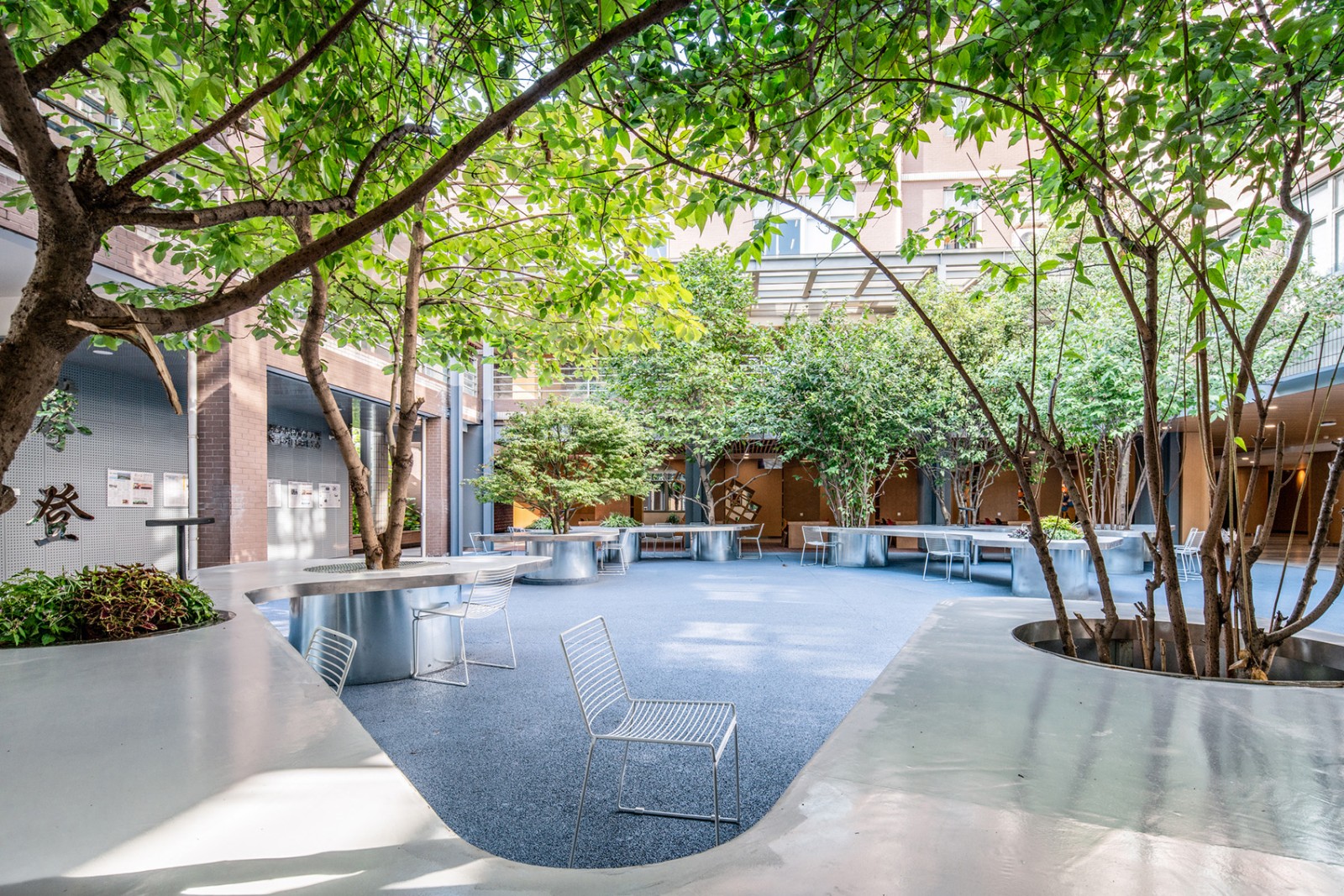
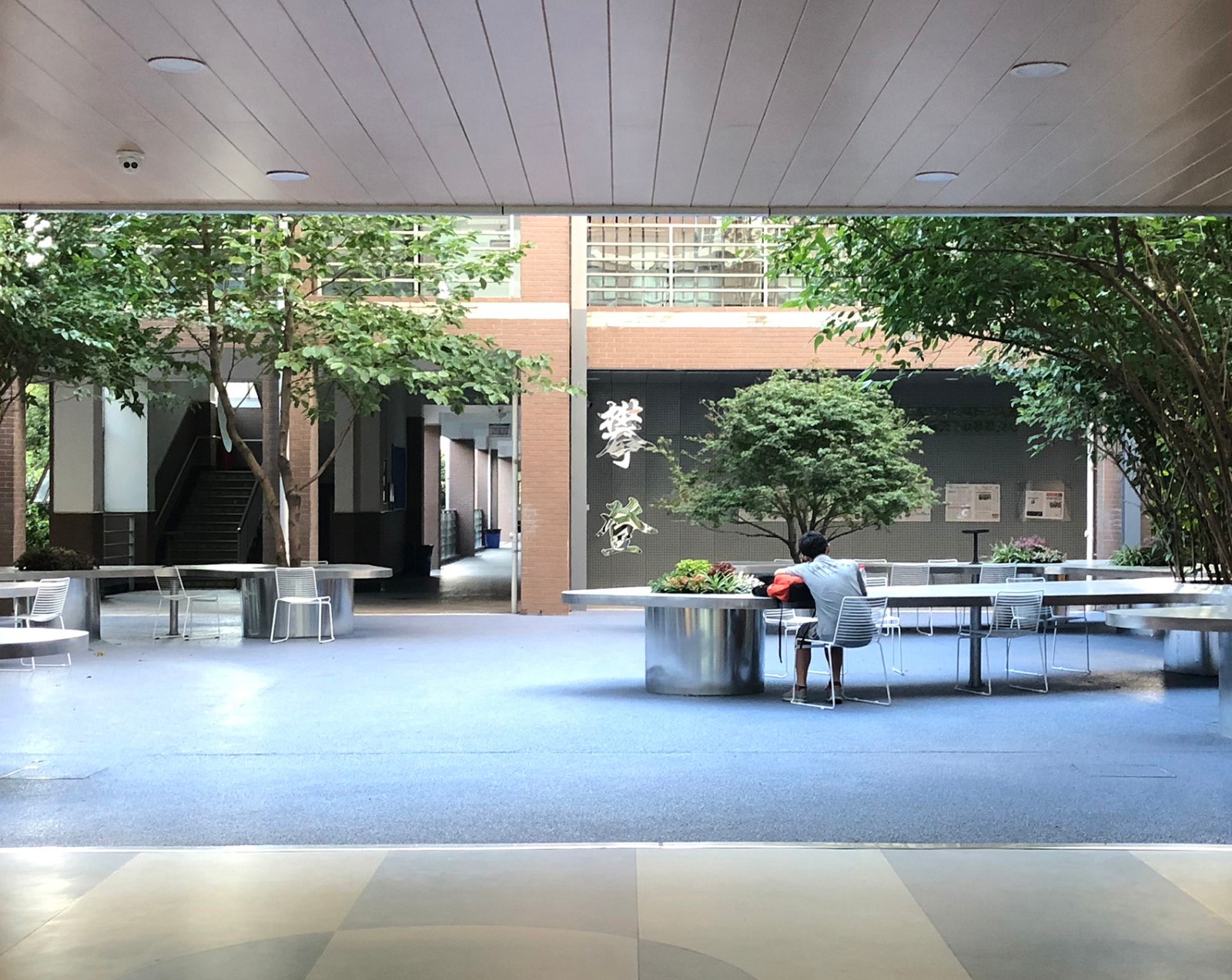
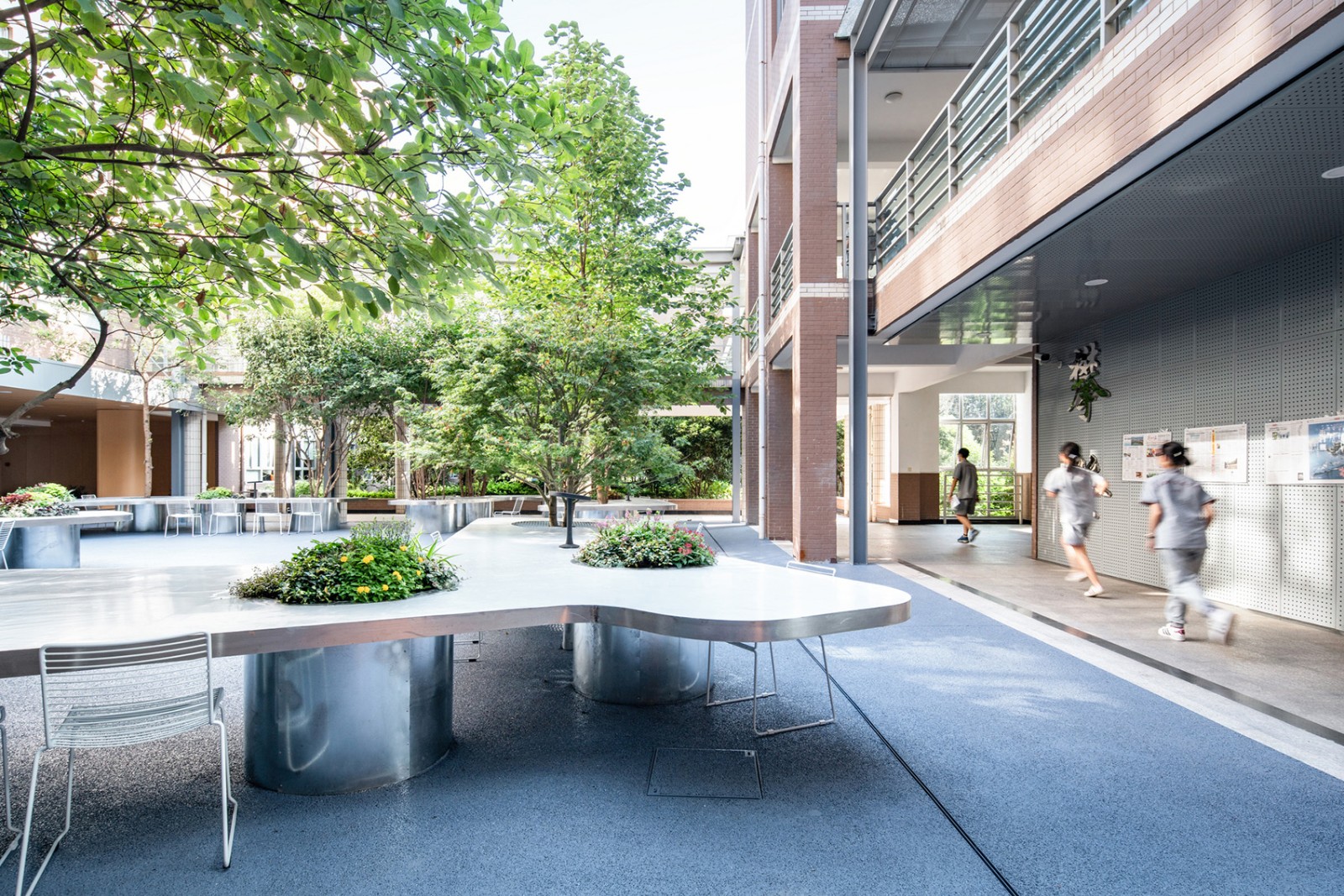
▲樹(shù)桌花園為校園帶來(lái)了開(kāi)放的戶(hù)外學(xué)習(xí)空間
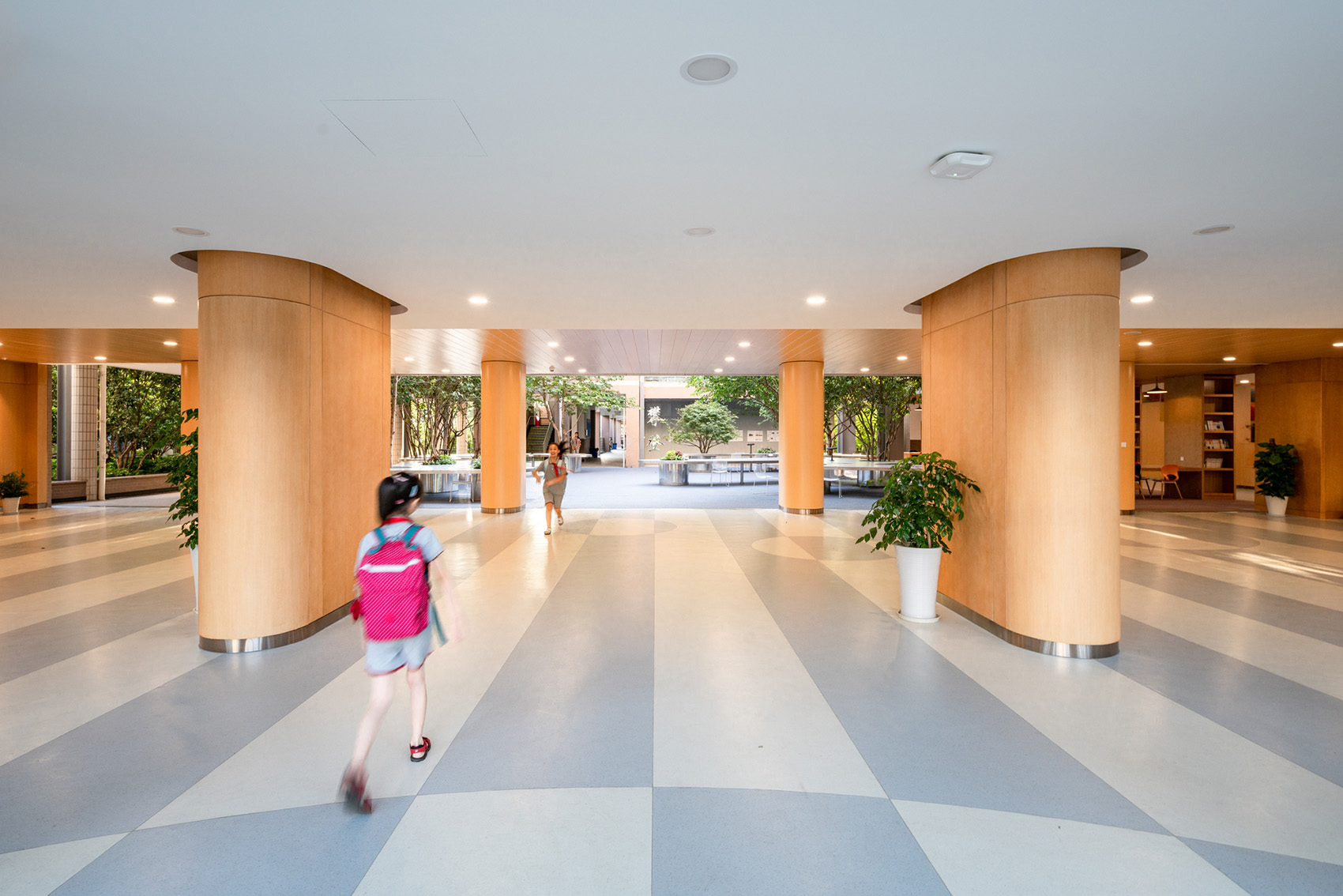
▲從大廳看樹(shù)桌花園
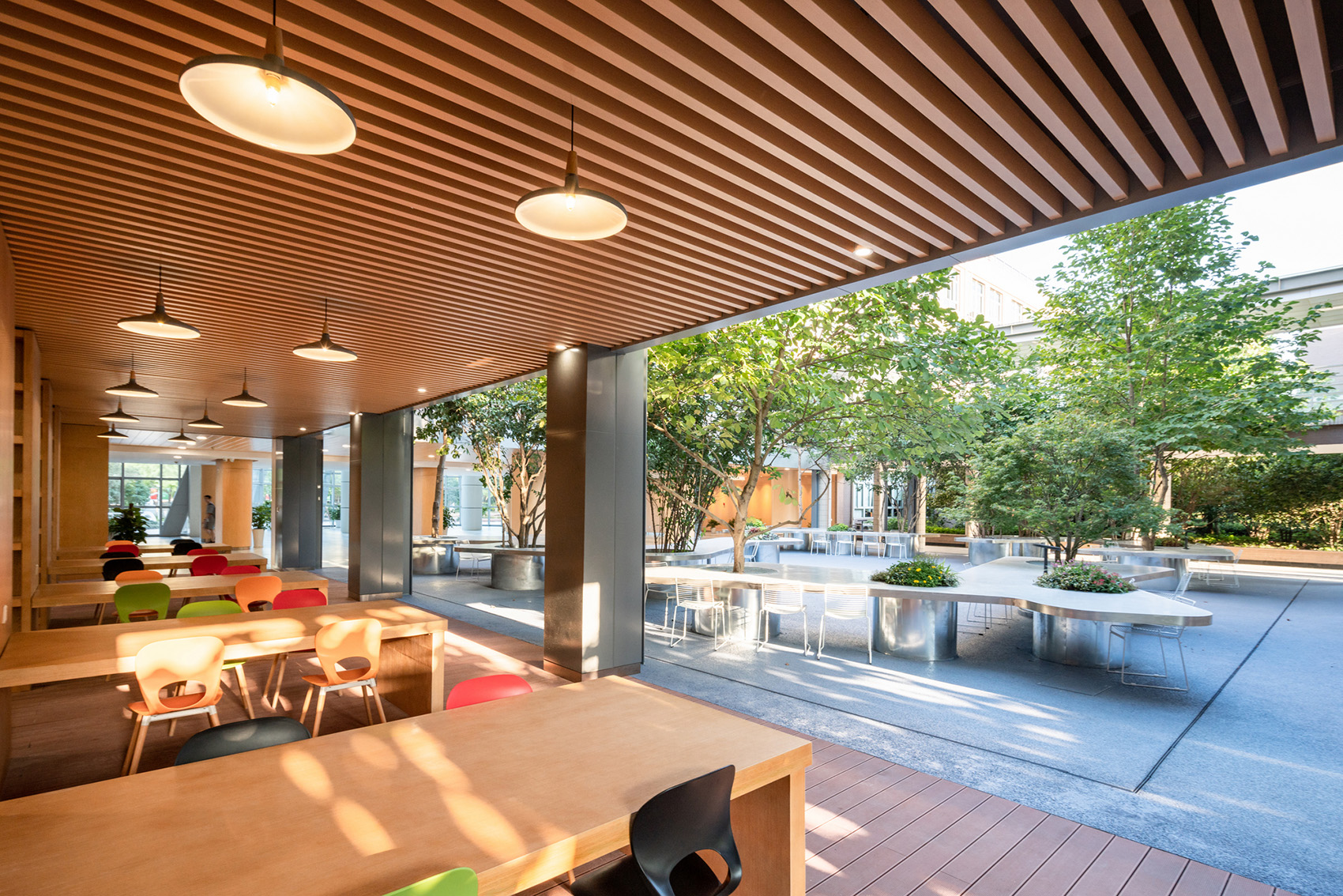
▲走廊改造后緊鄰樹(shù)桌花園
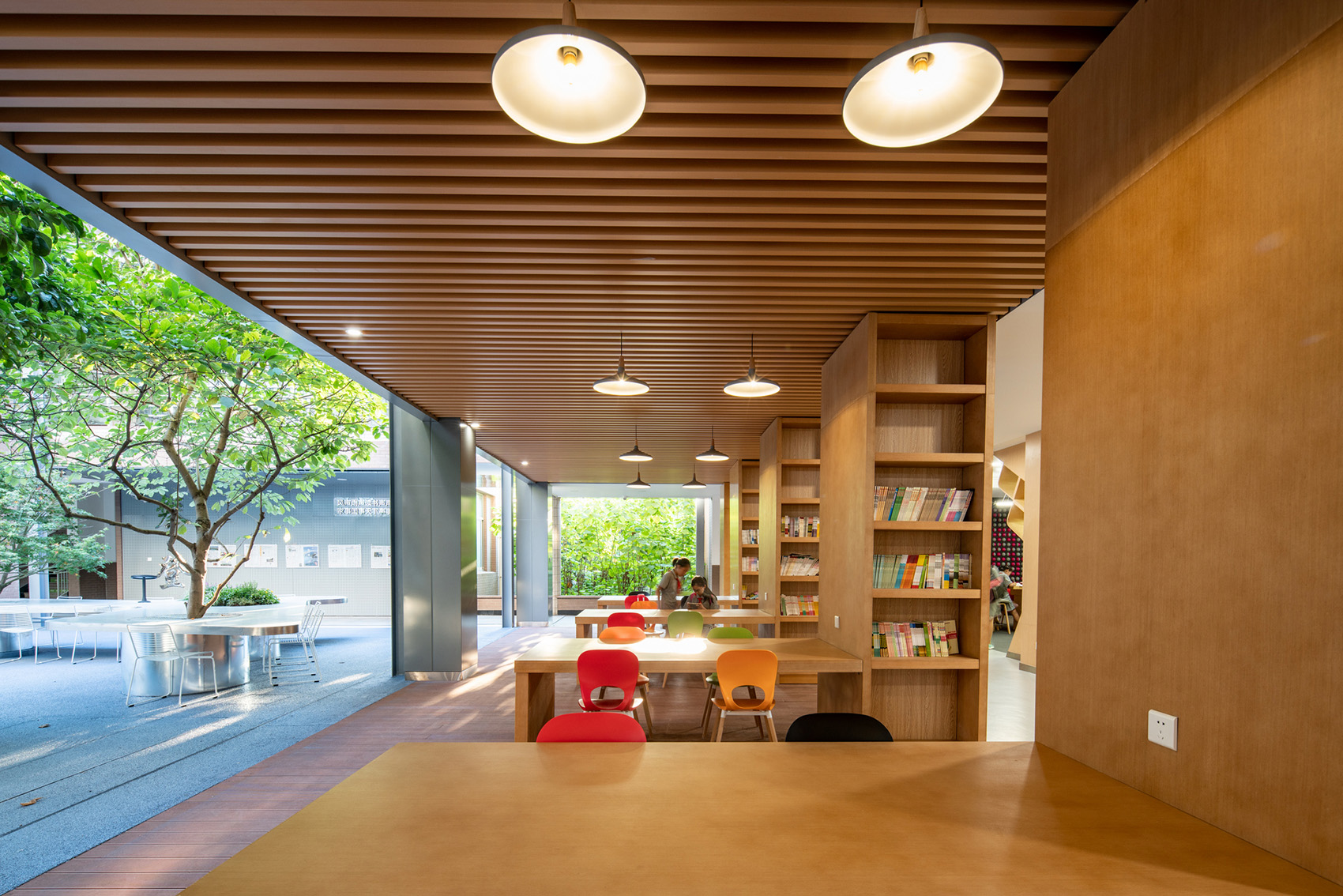
▲復(fù)合型學(xué)習(xí)空間
樹(shù)木保留與雨水管理
Tree retention and rainwater management
原生的11棵樹(shù)木都是非常普通的品種����,一點(diǎn)都不名貴。但是經(jīng)過(guò)多年的生長(zhǎng)��,已經(jīng)形成了綠意盎然的上層覆蓋����,設(shè)計(jì)保留和延續(xù)這個(gè)元素,也是在延續(xù)校園的記憶����,同時(shí)也是對(duì)生態(tài)的尊重。在保留了原生的11棵樹(shù)木的同時(shí)�����,疏于管理的灌木和地被層部分被移除了�����,取代的是能夠保障原生樹(shù)木透水透氣性的新的樹(shù)桌設(shè)計(jì)。
同時(shí)����,花園地面也采用了全透水地面,引導(dǎo)雨水快速下滲��,也減少地面濕滑�。考慮到建筑內(nèi)外平接的地坪���,為防止暴雨期間雨水倒灌入室內(nèi)����,花園四周采用了線形排水系統(tǒng)以便排掉多余的地面徑流���。
The original 11 trees are very common varieties, not at all expensive. However, after years of growth, the green upper layer has been formed, and the design retains and continues this element. It is also a memory of the campus and a respect for the ecology. While retaining the native 11 trees, the unmanaged shrubs and ground cover were partially removed, replacing the new tree table design that would protect the native trees from water and breathability.
At the same time, the garden floor also adopts a fully permeable ground to guide the rapid infiltration of rainwater and also reduce the wetness of the ground. Taking into account the flat floor inside and outside the building, in order to prevent rainwater from pouring into the room during heavy rain, a linear drainage system is used around the garden to drain excess ground runoff.

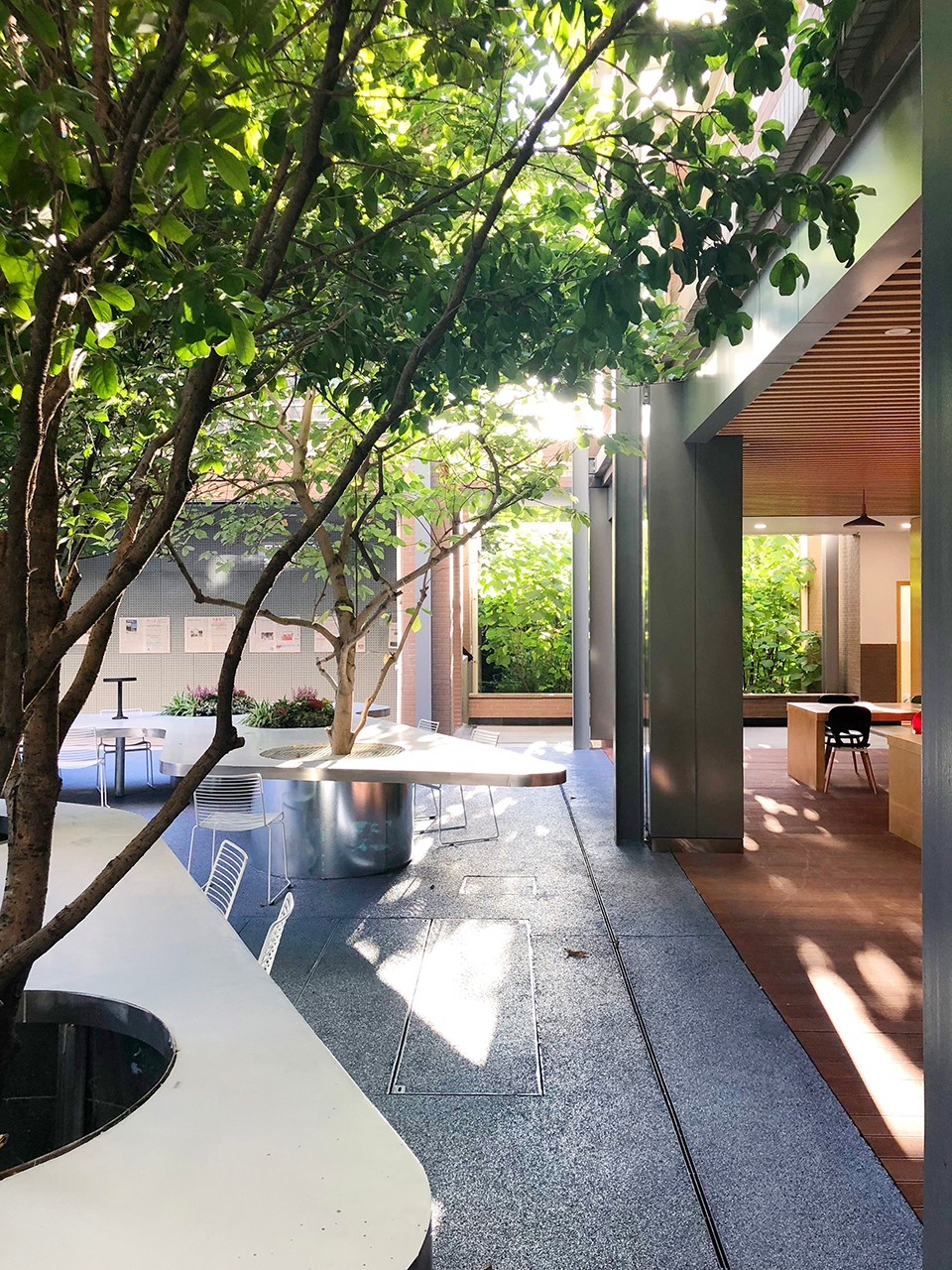
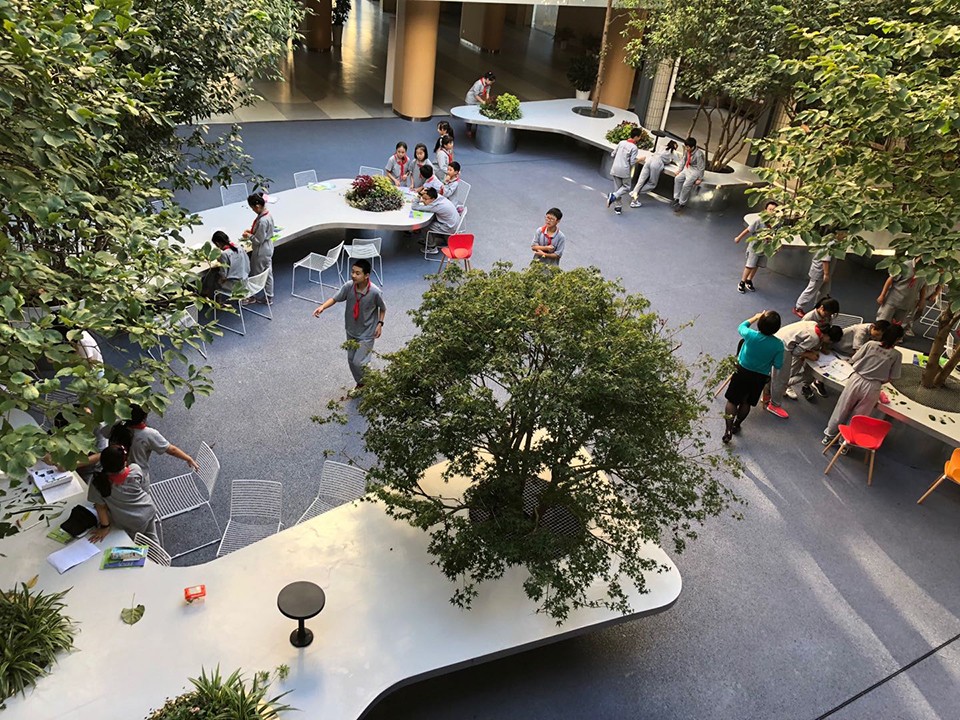
▲樹(shù)桌花園成為充滿(mǎn)活力的校園中心
結(jié)論?
In conclusion?
對(duì)比改造前的庭院和改造后的樹(shù)桌花園可以看到��,上層樹(shù)木依然繁茂��,然而樹(shù)下空間則發(fā)生了改變�����。由缺少活力的封閉綠地轉(zhuǎn)換為了一個(gè)充滿(mǎn)活力和趣味性的積極空間��,為學(xué)生們提供了室外上課��、做實(shí)驗(yàn)����、聚餐以及做游戲的新空間��,給學(xué)生生活帶來(lái)了更多的可能性��。
Comparing the courtyard before the renovation and the tree garden in the renovation, we can see that the upper trees are still flourishing, but the space under the trees has changed. The transition from a lack of vitality to a vibrant green space provides a new space for students to take classes, experiment, gather, and play games, bringing more possibilities to student life.
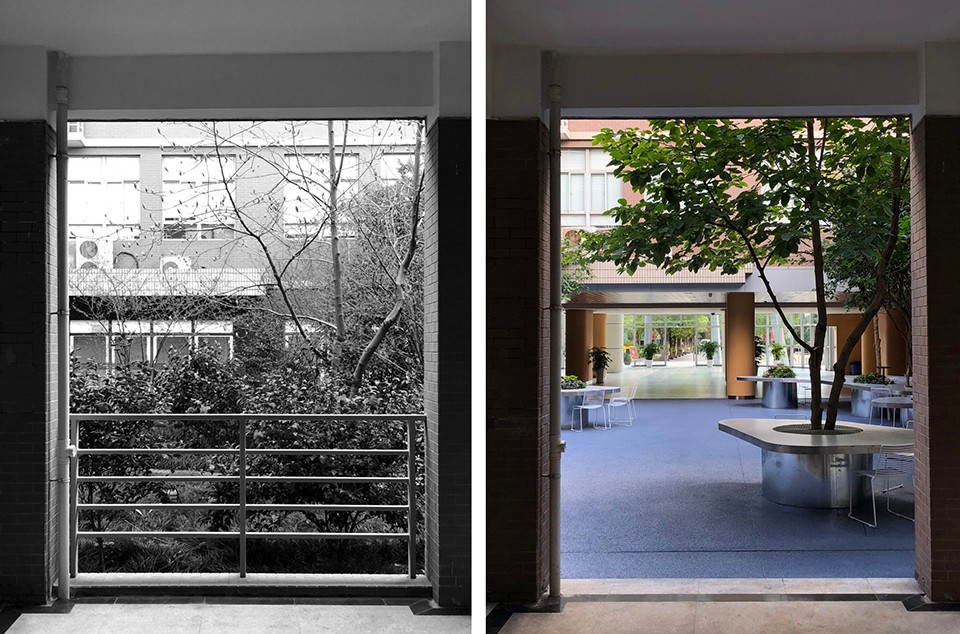
▲2015的庭院和2018的樹(shù)桌花園
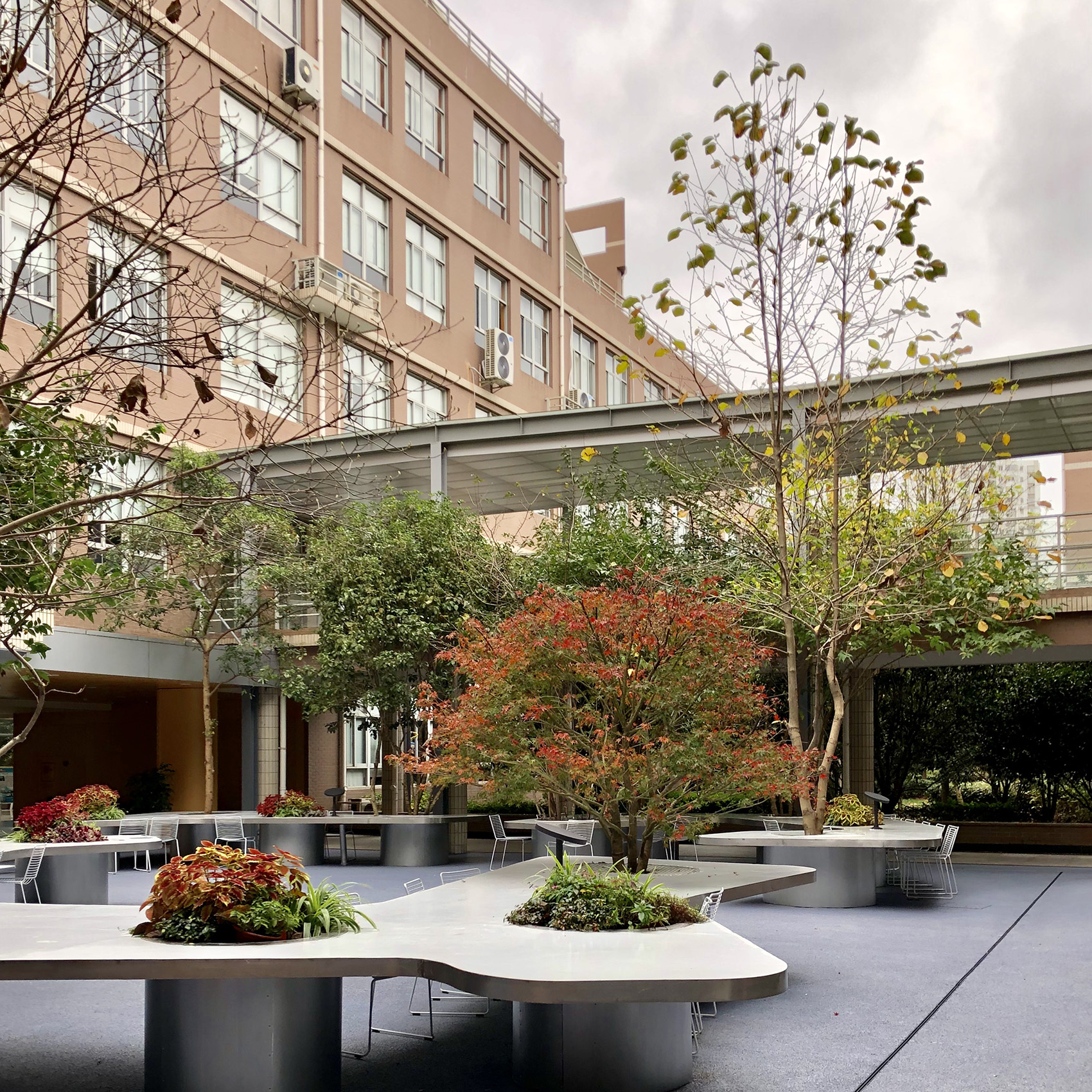
▲秋季的樹(shù)桌花園
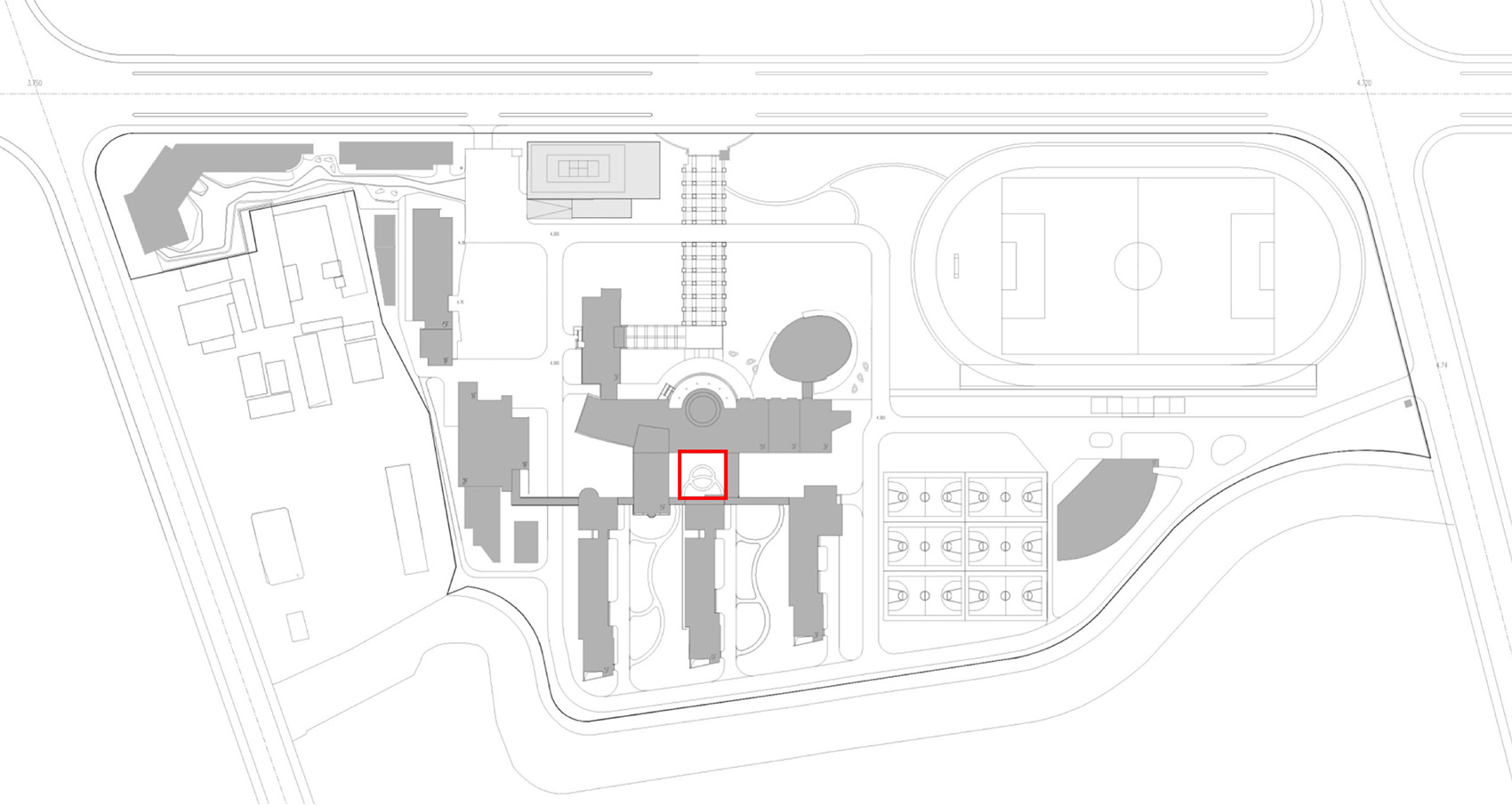
▲場(chǎng)地平面圖
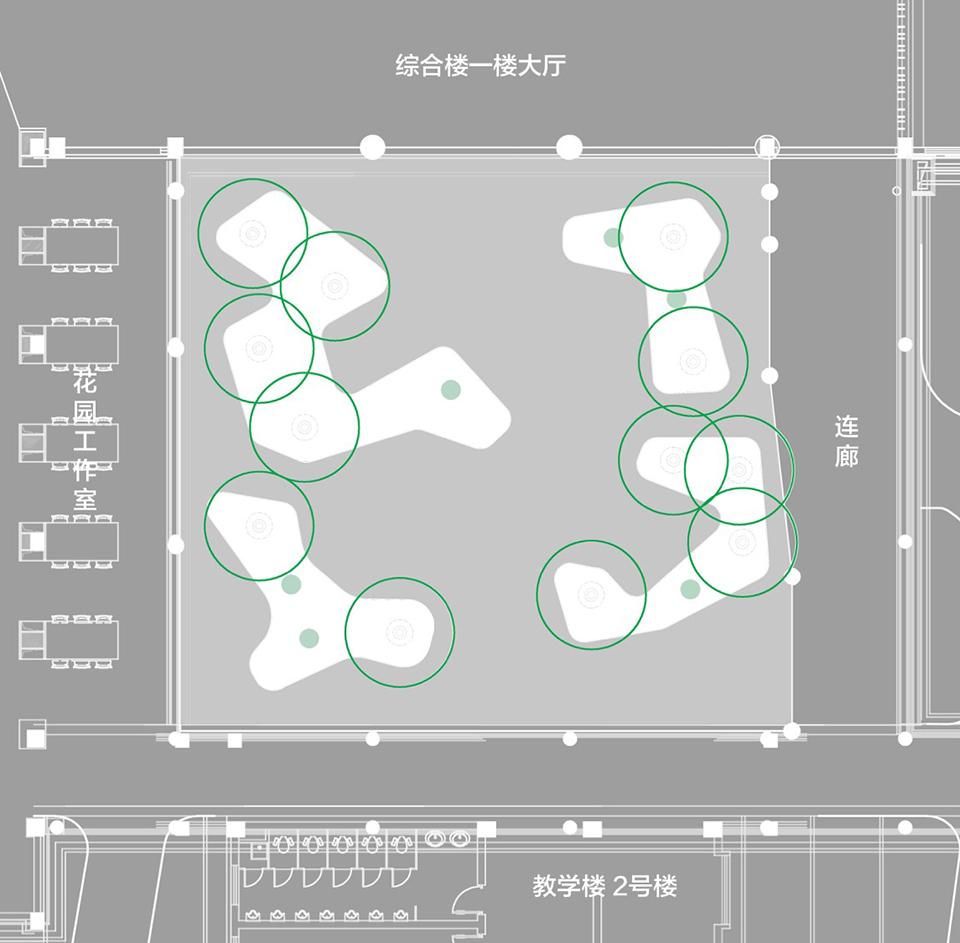
▲平面圖
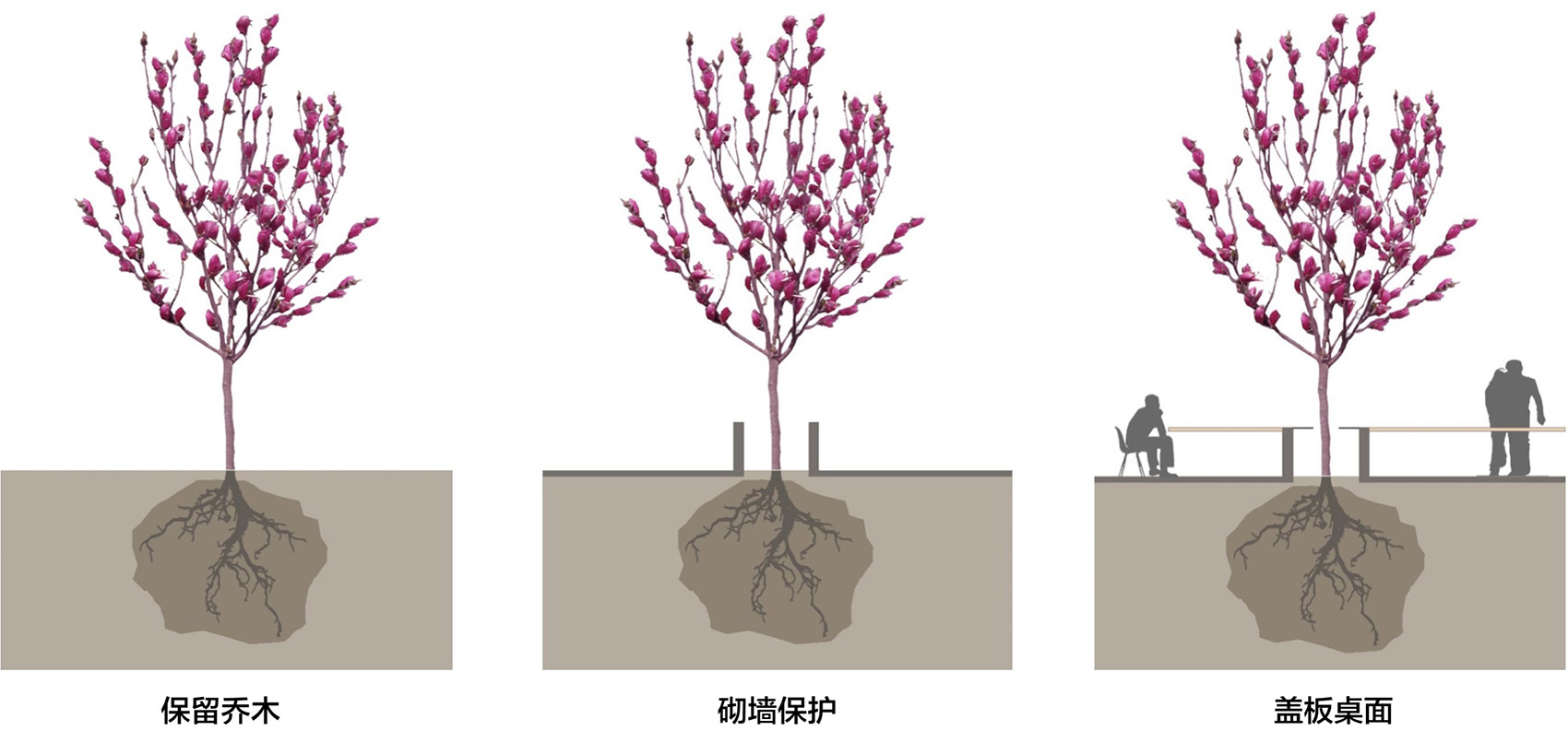
▲樹(shù)桌原理圖
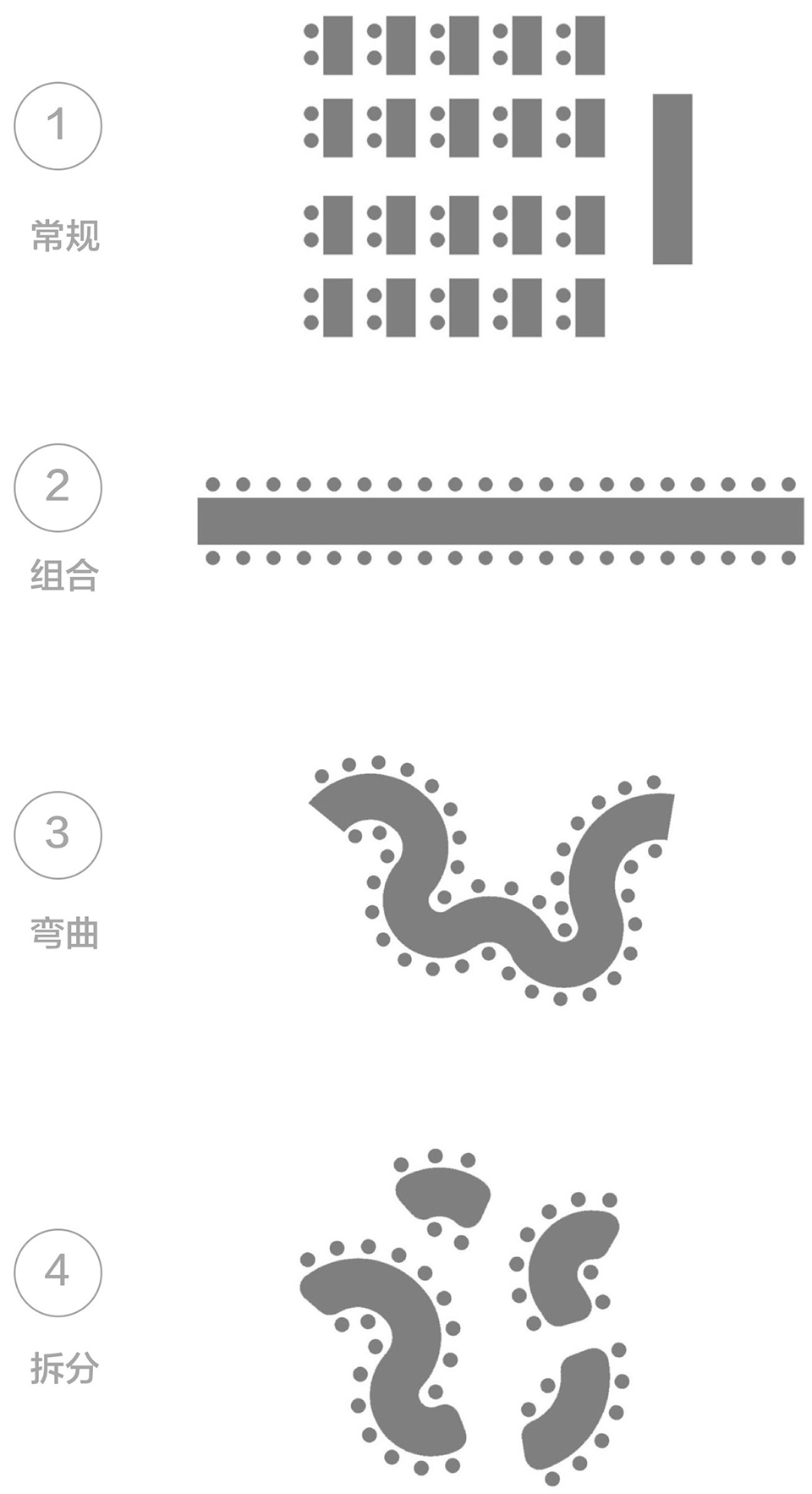
▲樹(shù)桌推導(dǎo)過(guò)程
版權(quán)聲明:本文版權(quán)歸原作者所有���,如有侵犯您的權(quán)益請(qǐng)及時(shí)聯(lián)系��,我們將第一時(shí)間刪除�����。
投稿郵箱:contact@landscape.cn
項(xiàng)目咨詢(xún):18510568018(微信同號(hào))
 京公海網(wǎng)安備 110108000058號(hào)
京公海網(wǎng)安備 110108000058號(hào)


























